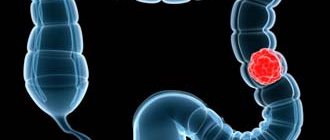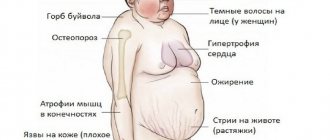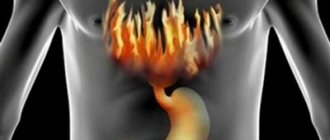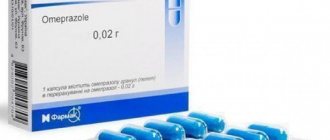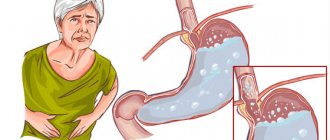Acute gastritis is an acute inflammatory process localized in the gastric mucosa.
It is caused by various reasons; the nature of the disease can be infectious or non-infectious. An infectious disease is considered to be a disease caused by the penetration of the microbe Helicobacter pylori and other infectious agents into the stomach from existing foci in the body - caries, otitis media, tonsillitis, cholecystitis. In other cases, inflammation is provoked by external causes. The disease code according to ICD-10 is K29.
General information
Gastritis is one of the most common diseases of the digestive organs, accounting for up to 80% of stomach diseases. The incidence of the disorder increases with age. According to observations in the field of gastroenterology, up to 70-90% of elderly patients suffer from various types of pathology. In recent years, cases of diagnosis of gastritis in children have become more frequent, the role of the bacterial factor in the development of inflammation has increased - up to 90% of cases are associated with Helicobacter pylori infection. The tendency towards a predominantly chronic course of the process remains; the prevalence of acute variants of the disease does not exceed 20%.
Children's gastritis
Recently, a disease such as gastritis has become more and more common. What reasons? This is due to the emergence of new products that contain flavoring additives.
Children are eating less and less healthy food and increasingly prefer flour, sweets, chips and crackers.
An incorrect daily routine also negatively affects the functioning of the digestive system. Children prefer to sleep longer, so in most cases they skip breakfast.
At lunchtime, children eat dry food, and in the evening they eat everything they haven’t eaten during the day.
At this age, poisoning and infectious intestinal diseases are common in children.
The symptoms of gastritis in children and adults differ significantly. In children, the main symptom is acute stomach pain. Additionally, diarrhea, lack of appetite, and vomiting occur.
Children with gastritis should never be treated at home. Only a gastroenterologist can determine treatment. For example, rehabilitation therapy with medications.
The doctor determines the required dosage and number of appointments.
General classification
There are two forms of development of this pathological process - acute and chronic. The acute form of this inflammatory disease is divided into the following subtypes:
- catarrhal;
- phlegmonous;
- toxic-chemical;
- fibrinous.
The catarrhal form of pathology is the simplest and most common. It can be installed using gastroscopy. This type of gastrointestinal disease occurs from mild food poisoning, allergic reactions, overeating or frequent nervous tension. As a rule, the basis of the symptoms are the following indicators: unpleasant odor from the mouth and its dryness, vomiting with parts of food, weakness and temperature.
Toxic-chemical or necrotic illness occurs from exposure to chemicals. The disease forms scars in the intestines, which significantly impair the patient’s life. The disease is characterized by certain symptoms - increased thirst, pain, a general feeling of weakness, pale skin, nausea, and occasionally vomiting.
The classification of acute gastritis ends with the phlegmonous form. This is the most dangerous type of illness that develops from the catarrhal form. All layers of the stomach walls are affected. This type of gastritis requires urgent surgical intervention.
The classification of chronic gastritis consists of the following forms:
- bacteria-associated Helicobacter pylori;
- autoimmune;
- chemically mediated;
- idiopathic;
- eosinophilic;
- granulomatous.
Based on the production of gastric juice, the following types of illness are distinguished:
- with increased levels of hydrochloric acid;
- with low acidity.
At the time of the biopsy, the doctor may detect the development of chronic gastritis in the following forms:
- non-atrophic - the gastric gland is damaged, but it does not atrophy;
- subatrophic - partial necrosis of the pancreas;
- mixed - suppuration in the mucous membrane, due to which the tissues of the organ become necrosis.
Chronic gastritis can develop into an ulcer, and patients with two complex gastrointestinal diagnoses form an oncological risk group.
Causes
From an etiological point of view, it is advisable to distinguish between two forms of acute gastritis. In some cases, we are talking about acute irritation of the stomach by a harmful factor coming from the outside - this is exogenous, or irritative, gastritis. In another series of cases, inflammatory processes in the stomach are the result of internal harmfulness circulating in the blood - this is endogenous, or hematogenous, gastritis.
Irritative gastritis appears as a result of a number of external irritations of the stomach. In the foreground, of course, are numerous cases of food irritation, and both the quantity and quality of food, both together, are of particular importance here. With regard to these food irritations, however, the individual characteristics of each person's stomach are decisive. Along with people who digest any amount of any food with impunity - people with the so-called “tinned” stomach, there are people who react to the slightest deviations in food - both qualitative and quantitative - with “spoiled” digestion - symptoms of acute gastritis. Moreover, the same person, depending on the general condition of the body, physical fatigue and his psychoneurological attitude, reacts differently to the same food at different times and gets acute gastritis “for no apparent reason.” This is partly dependent on changes in the secretion and motor work of the stomach under the influence of psychoneurological fatigue or affect. The primary phenomena are stagnation of food and poor digestion in the stomach, hence the decomposition of food and irritative gastritis. This is why asthenics and people prone to gastric hypotension so often suffer from acute gastritis.
Of course, in addition to completely benign food during overeating, especially after periods of abstinence from food, spoiled food is of even greater importance in the origin of acute gastritis. Hence, irritative gastritis becomes more frequent in the summer, when food - especially protein - easily decomposes and becomes contaminated with insects. Hence gastritis as a result of eating poor quality products, bordering on food poisoning. Accordingly, such low-quality food easily causes massive acute gastritis.
Acute gastritis occurs frequently and due to the toxic effect on the stomach of substances circulating in the bloodstream. We are talking about toxic effects on the stomach, no matter whether these toxins are of exogenous origin, as is the case in acute infectious diseases, or endogenous, as in uremia, gout, diabetes, cholemia and other metabolic disorders, or, finally, when they circulate in the blood substances that, under certain conditions in minimal quantities, still often cause severe symptoms of acute gastritis in a given person, are so-called allergic gastritis.
In a number of infectious diseases, the clinical picture of the disease is accompanied by typical symptoms of acute gastritis. Also, the occurrence of gastritis is promoted by infection of the stomach with Helicobacter pylori and other bacteria or fungi.
Close to allergic acute gastritis are some forms of gastritis of medicinal origin. The best example of this is gastritis from taking iodine, which in minimal quantities causes very acute gastritis in some people, from taking small doses of quinine, aspirin, etc.
The very first classification of chronic gastritis
The first systematization of chronic gastritis represented a group of three types of gastritis, proposed in 1973. Included types of stomach diseases:
- Autoimmune (Type A) - characterized by damage to the mucous membrane within the body of the stomach.
- Infectious (Type B) – characterized by damage to the mucous membrane due to infection by Helicobacter pylori.
- Toxic-chemical (Type C) - characterized by damage to the gastric mucosa, the causes of which lie, firstly, in the formation of reflux of contents from the duodenum into the stomach, and secondly, by taking medications that have a detrimental effect on the mucous membrane of the gastric wall.
Diagnostics
To differentiate the diagnosis, laboratory and instrumental methods are used.
The doctor prescribes laboratory tests of urine and blood, in the presence of loose stools and profuse vomiting, and conducts a bacteriological examination of vomit and feces to exclude the infectious nature of the pathology.
Of the instrumental methods, gastroscopy is used, during which it is clear that the gastric mucosa is extremely congested and very swollen. Ultrasound diagnostics of the abdominal cavity can exclude inflammation of the pancreas, liver and gall bladder. To exclude acute appendicitis, the patient is examined by a surgeon.
Sydney classification
The second in origin and first in importance is the classification of chronic gastritis, adopted in Sydney in 1990. This includes the following headings: classification according to the volume of the lesion, the speed of clinical development, the morphological structure of the defect, and its origin.
Each section includes many subsections. In order to correctly and completely make a diagnosis and prescribe treatment, it is necessary to take into account all the headings. Let's sort it out in order.
Speed of development of the clinical picture
This classification represented the division of gastritis into main types according to the severity of symptoms and clinical picture. Diseases were divided into acute (suddenly appearing complaints in the form of epigastric pain, nausea, forcing a person to take a forced position, the causes were in diet errors), chronic (developing over years, when the clinical picture is not expressed or the person is not bothered by pain at all) and other forms. Other, or special, forms included types: granulomatous, reactive, lymphocytic and others.
Volume of lesion
The Sydney classification included a division according to the anatomical region in which the lesion occurred: gastritis of the body of the stomach, antrum, or pangastritis (when the entire hollow organ is involved).
Morphology
According to changes in morphology, the classification of chronic gastritis included: atrophy, metaplasia. The degree of inflammation was described. If this is a superficial form (within the mucous membrane of the gastrointestinal tract), it is indicated: when exudate is released - exudative. If there is no exudate, only hyperemia, the erythematous form is evident. The shape of the erosions is also described: whether they are flat or raised, whether hemorrhages or hyperplastic cells are present. Is gastroesophageal reflux associated? All of the above can be described using endoscope visualization.
Etiology
According to the factor of origin of the disease: H. pylori positive (infectious) and non-infectious causes: conditions caused by excessive use of non-steroidal anti-inflammatory drugs, alcohol. Autoimmune aggression against stomach cells. Exposure to chemicals.
The diagnosis of chronic gastritis is based on all four signs: the presumed cause of the disease, the location of the defect, histo- and macroscopic changes in the membrane.
Visual scale
The advantage of the Sydney classification is the presence of a visual analogue scale, which includes the degree of severity of morphological and histological changes in the mucosa. Signs are assessed using a point system. 0 – no changes, 1 – minimal manifestation, 2 – moderate manifestation of the symptom, 3 – significantly expressed manifestation.
Forms of pangastritis
Regardless of the form in which pangastritis develops, the symptoms of the disease in the early stages are similar. A person begins to experience sudden irritability and drowsiness after eating, complain of loss of appetite and burning in the mouth, unpleasant tingling in the legs and arms. This is followed by loss of appetite, nausea, heartburn and bowel movements. Further symptoms will be different for each form of functional activity.
There is one disease, but it has several types
Pangastritis with moderate or strong secretory function
According to researchers, this type of pangastritis is most common in middle-aged patients; in the elderly it is much less common. Among its distinctive features are the following: heaviness in the abdomen, incessant heartburn and belching with a pronounced sour taste. Characteristic pain can occur on an empty stomach, often when going to bed.
Complaints of digestive problems and regular constipation are also common.
Diagnosis of pangastritis with moderate or strong secretory function is carried out by a specialist by palpation of the stomach area. In this case, the patient, as a rule, feels a sharp pain “in the pit of the stomach.” If the suspicion of the diagnosis is confirmed at the first examination, an analysis of gastric juice and a fluoroscopy procedure and fibrogastroscopic examination are performed.
Pangastritis with insufficient secretion
Unlike the previous form of pangastritis, this type mainly affects people of retirement age. The patient suffers from periodic nausea, a constant unpleasant taste inside the mouth, bloating and regular diarrhea. One of the most obvious signals is also the emergence of difficulties with the absorption of dairy products, which did not exist at a younger age.
The problem associated with diagnosing pangastritis in elderly men and women directly stems from the general condition of their body. The symptoms of pangastritis may coincide with other diseases of the gastrointestinal tract, including:
- secondary hepatitis;
- chronic cholecystitis;
- enterocolitis;
- pancreatitis.
Therefore, it is usually not possible to make a correct diagnosis of pangastritis with insufficient secretion by primary palpation of the stomach. During subsequent X-ray examinations, the doctor pays attention to the presence of compactions in the folds of the mucous membrane. If these compactions occur against the background of thinning of these folds, we are talking about pangastritis.
Houston classification
In this case, scientists distinguish types of chronic gastritis, based on different categories and etiology of the disease. In this theory, gastritis has certain varieties that do not have a study of secretory function and the stages of the disease are not taken into account. According to the creators of the classification, chronic gastritis occurs:
- non-atrophic anacidic or hypoacid - the body is affected by the bacterium Helicobacter pylori;
- atrophic antral diffuse - develops from an autoimmune process;
- atrophic multifocal diffuse - progresses due to poor nutrition, damage to the secretion of gastric juice or from the bacterium Helicobacter pylori;
- chemical - provoked by bile or frequent use of drugs;
- radiation - due to radiation damage;
- lymphocytic - due to immune disorders and the bacteria Helicobacter pylori;
- erythematous - the deep layers of the organ are not affected;
- exudative - progresses under the influence of chronic ailments;
- follicular - rarely diagnosed.
The developers of this classification did not base their achievements on the clinical and functional properties of the disease, so in practice doctors do not use it.
Types of gastritis
Based on the nature of the onset and course of the disease, and the speed at which symptoms manifest, two types of gastritis are distinguished: acute and chronic.
- Acute gastritis is diagnosed when the patient first visits a medical facility. The disease is characterized by the presence of attacks of pain and rapid progression.
- Chronic gastritis is characterized by periodically recurring attacks and inexpressible pain. They are not so pronounced, but have their own character. It usually develops if the disease, which occurred once in an acute form, was not cured. It can last more than one year, but torment the patient for decades.
Based on the extent of damage to the gastric mucosa, doctors distinguish between the following types of gastritis:
- catarrhal;
- erosive;
- phlegmonous;
- atrophic;
- autoimmune;
- hypertrophic;
- allergic;
- infectious;
- necrotic;
- granulomatous;
- idiopathic.
One form of gastritis can transform into another if not treated correctly. Also, in the absence of help, the patient develops a stomach ulcer or cancer, which is much more difficult to cope with than the primary manifestation of the disease.
New classification
According to the new classification developed by German scientists, the following forms of this disease are distinguished:
- autoimmune;
- Helicobacter;
- mixed;
- chemical-toxic;
- lymphocytic;
- special types.
At the present stage of medicine, an accurate diagnosis can be made thanks to a complete examination, correct test results and a detailed description of the disease. Most often in practice, doctors use the detailed classification of Ryss, and the other types of gastritis presented remain its addition.
Features of different types according to classification
- Granular gastritis is characterized by the appearance of elevations in the form of “grains” on the gastric mucosa, which reach from 1 mm to 5 mm. This is a type of hypertrophic form of the disease, the typical signs of which are asymptomatic progression and the appearance of large folds on the stomach, between which mucus and gastric juice accumulate. Granular gastritis is treated over a long period of time; an individual regimen is selected for each patient.
- Anacidic gastritis - appears against the background of reduced acidity; in this form, hydrochloric acid is practically not released. Against the background of such a disease, the protective function is reduced, and there is no sufficient bactericidal effect.
- Eosinophilic gastritis is an inflammation of the gastric mucosa with the release of exudate. The disease is dangerous due to the involvement of nearby organs in the pathological process.
- Achilles gastritis is a type of disease with reduced acidity, pronounced dyspeptic disorders appear, but pain is not the main manifestation. The patient's appetite decreases, but at the same time hunger pains may be present, which aggravates the overall serious condition. Achilles and antacid gastritis often occur simultaneously.
- Allergic gastritis - has its own specifics, appears against the background of an autoimmune disorder, and any food can be an allergen. Allergic gastritis responds well to drug treatment and diet therapy.
- Uremic gastritis occurs against the background of pre-existing kidney disease. The body is poisoned with urea, which accumulates in the gastric juice.
The presented types of disease in each patient have specific manifestations, which are influenced by the state of the immune system, concomitant diseases and age.
Principles of treatment in adults
The main method of treating acute gastritis is following a fasting diet for 1 - 2 days until acute symptoms are relieved. These days, the patient is allowed only warm drinks in the complete absence of any food. A fasting diet ensures sparing of the gastric mucosa and gradual subsidence of inflammation.
During this period, tablet medications are not used, since they also act as a chemical irritant to the digestive tract. If the patient suffers from severe pain, analgesics are administered parenterally.
If the patient's condition is severe due to repeated vomiting, after gastric lavage he is hospitalized and given infusion therapy in the hospital to prevent dehydration.
The diet for acute gastritis has strict restrictions that must be followed. Otherwise, the disease may become chronic.
Diet therapy
A gradual transition to a normal diet begins after the pain subsides.
In the first days after an exacerbation, the patient is allowed to drink jelly or kefir, and for lunch they are offered mucous soups or a light broth made from lean meat. Liquid mashed potatoes and porridges, dishes made from pureed meat or minced meat, steamed, are gradually added to the diet. A smooth transition to traditional nutrition lasts at least 2 weeks. At this time, boiled and stewed dishes, baked omelettes, and non-acidic fruit purees are allowed.
As a preventative measure, observe food hygiene:
- Buy only good quality products and store them correctly.
- Do not eat thermally unprocessed foods, pungency, spices, marinades.
- Handle household chemicals carefully and do not store them near food products.
Superficial inflammation
A mild form of pathology occurs most often due to poor nutrition, bad habits, and stress. Clinical manifestations of superficial inflammation concern constant discomfort in the stomach, heaviness after eating, and minor pain.
Patients experience dyspeptic disorders: diarrhea, nausea, vomiting, possibly bleeding from vomit. Typical disorders for this form are signs of abundant mucus formation, increased infiltration and inflammation of the mucous layer.
The risk group includes people with concomitant gastrointestinal pathologies and who do not have a proper diet. Alcohol and smoking are harmful to the whole body, but the stomach suffers first. The disease can also be provoked by the opportunistic bacterium Helicobacter, without which other serious diseases of the stomach and duodenum cannot occur.
Treatment of the superficial form of inflammation is carried out comprehensively:
- Medical nutrition is prescribed with the exclusion of aggressive products that affect the increase in acidity and irritation of the mucous layer.
- The stress factor that triggers unpleasant symptoms of the disease is eliminated. So, during times of fear or unpleasant experiences, a person begins to experience severe stomach pain.
Drug therapy used:
- antacids;
- painkillers;
- non-steroidal anti-inflammatory drugs;
- antibacterial substances.
Patients can carry out treatment at home using methods that do not contradict traditional medicine.
This form of the disease is easily amenable to conservative therapy, but proper nutrition should come first.
Symptoms of the disease
Chronic gastritis - causes, symptoms, treatment, dietary table
In the early stages, the disease manifests itself as a weakening of gastric motility and a reduction in the production of digestive secretions. Later the symptoms intensify. And without timely treatment, complications are possible.
- Heaviness, tightness, bloating in the abdomen
- Nausea, heartburn, unpleasant taste in the mouth
- Decreased appetite, weakness, fever, low-grade fever
- Abdominal pain - dull aching, sharp, pressing, burning (especially after eating or at night), sometimes radiating to the back
- Painful abdomen in the stomach and upper abdomen
Hospitalize immediately! If there is a large amount of transparent, yellow, green vomit, including interspersed with blood, as well as other signs of severe gastritis - black or red feces, shortness of breath, chest pain, fainting, severe abdominal pain with fever, shortness of breath.
- Peptic ulcer disease. Ulcerations of the mucous membrane increase the likelihood of bleeding.
- Penetration (destruction) of the gastric walls. Toxins leak through the cracks and attack the nerves and receptors of the gastrointestinal tract. The result is fistulas and necrosis.
- Neoplasms.
Signs of acute gastritis usually appear suddenly against the background of errors in diet, taking NSAIDs, or poisoning. Patients are concerned about epigastric pain of varying intensity, nausea, vomiting, belching, loss of appetite, and increased frequency of stools. Violations of the general condition in acute inflammation are represented by weakness, dizziness, and decreased ability to work. With an infectious genesis of the disorder, fever, chills, runny nose, cough, myalgia, and arthralgia are possible. A feature of the erosive variant of the disease is the presence of bleeding from the gastrointestinal tract, which manifests itself in the form of hematemesis or melena.
Symptoms of chronic gastritis depend on the secretory activity of the stomach. Inflammation, accompanied by increased acidity, is characterized by intense pain in the epigastric area, occurring 20-30 minutes after eating, chronic constipation, heartburn, and sour belching. With a long course, the patient is concerned about increased fatigue, emotional lability, and insomnia. In patients suffering from chronic gastritis with low acidity, the pain syndrome is mild or absent. There is morning sickness, a feeling of rapid satiety, heaviness in the stomach, diarrhea, flatulence, belching of air, a bitter taste in the mouth, and a gray coating on the tongue. Due to impaired digestion and absorption of food, weight loss, muscle weakness, and swelling in the legs are observed.
The signs of chronic gastritis are quite characteristic; they manifest themselves in the following:
- cutting pain in the stomach area;
- heartburn, belching, nausea;
- unpleasant taste;
- feeling of heaviness;
- vomit;
- bloating;
- bowel dysfunction, constipation or diarrhea.
Pain in chronic gastritis is usually sharp and cramping, occurring most often in the morning or at night.
Symptoms also differ depending on the level of stomach acidity and the ability or inability to maintain the secretion of hydrochloric acid.
Manifestations of chronic gastritis with low acidity:
- bloating;
- constipation;
- heartburn;
- unpleasant taste;
- poor appetite.
Symptoms of chronic gastritis with high acidity:
- pain is aching, dull or sharp, cutting;
- hunger pains;
- belching (tasting like a rotten egg);
- feeling of a full stomach;
- diarrhea;
- nausea.
The development of chronic gastritis with increased secretory function is often observed in young people. Usually the mucous membrane is affected superficially, sometimes affecting the glands, but without atrophy.
Atrophic gastritis
Atrophic gastritis is one of the extremely unfavorable types and is considered a precancerous disease. With this type, cells lose the ability to adequately perform functions, gradually losing their normal structure and becoming flattened. Dangerous due to probable degeneration into cancer, sluggish course, poor clinical picture, which prevents timely diagnosis of the pathology.
Why does this happen?
- Stage 1 of pathogenesis is the same for the disease: all types of inflammatory process on the mucous membrane begin from this stage. Cells of the gastric mucosa are exposed to Helicobacter pylori, and under their influence, the environment changes to a more acidic side in a certain place in the stomach. The basis is created for further progression of the disease.
- Stage 2 involves the body’s autoimmune action against its own lining cells of the stomach, they stop functioning. Cells with an altered structure can no longer regenerate. The function is leveled, hydrochloric acid for gastric juice is not produced. Only mucus is produced, which, in turn, covering the walls of the stomach, protects it for some time from harmful influences. When examined with a fibrogastroscope, an inexperienced eye may miss areas of atrophy under a thick layer of mucus. With subsequent growth, atrophic cells develop, completely filling the gastric mucosa, and become unable to perform the main function of digesting food. The cells hypertrophy and turn into cancer cells.
The atrophic subtype is divided into:
- surface;
- antral;
- focal;
- acute and chronic atrophic gastritis;
- moderately atrophic gastritis.
What types of gastritis are there?
Atrophic gastritis. The main symptoms of this disease are: enzyme deficiency, problems with digesting food.
The patient feels constant pain, heaviness in the stomach, which intensifies after eating.
Additionally, an unpleasant taste appears in the mouth, appetite worsens, flatulence, diarrhea or constipation appear.
Acute gastritis. Painful sensations appear in the upper part of the stomach, additionally there is increased salivation, weakness, tachycardia, causes vomiting, frequent diarrhea, and general malaise.
Chronic gastritis. This is gastritis that has been healed. It can appear at any moment. This can happen at any time of the year, but especially in the fall and spring.
It is necessary to constantly follow a diet, eliminate all bad habits and undergo treatment twice a year.
What types of gastritis exist depending on the cause?
The appearance of chronic gastritis occurs due to the following reasons:
- Chemical. It occurs due to taking certain types of medications that lead to the reflux of bile into the stomach.
- Autoimmune. The inflammatory process is caused by antibodies to the parietal cells of the stomach.
- Bacterial. Gastritis is associated with bacterial damage to the stomach walls.
Gastritis is also distinguished depending on the location:
- Pangastritis.
- Gastritis of the main body of the stomach.
- Gastritis of certain parts of the stomach.
Non-atrophic gastritis
As stated above, a common cause of the disease is Helicobacter pylori infection. Sources include: gastric surgery, immune system disorders, bacterial contamination, alcohol abuse. It is noted that this is the most common and “harmless” type of gastritis.
The disease manifests itself with complaints of heartburn, taste in the mouth, pain and heaviness in the epigastric region after the next meal. With timely diagnosis, the disease can be quickly cured without residual effects.
For prevention, it is possible to use bifiform capsules, which normalize the balance of microflora.
Causes and mechanism of development of pangastritis
Scientists include the most common causes of inflammation of the stomach wall:
- unhealthy diet: eating fast food, chips, crackers, carbonated drinks and other food garbage, eating on the run, dry food, lack of breakfast and large meals in the evening, the habit of washing down food with cold liquid;
- infection of the body with Helicobacter, which penetrates the gastric mucosa and causes a local allergic reaction;
- poisoning by poor-quality food, certain chemicals;
- taking drugs from the group of NSAIDs, analgesics, glucocorticosteroids;
- frequent stress, traumatic situations;
- smoking and alcohol abuse.
Exposure to any of these provoking factors leads to microdamage, disruption of microcirculation, and, ultimately, to chronic, low-grade inflammation of the stomach wall.
Special forms
Includes a list of species that did not find a place in other sections: eosinophilic, reactive, radiation and others.
Localization of gastritis
Location in the area of the body of the stomach, antrum or both parts, covering both curvatures of the stomach. Prevention of gastritis and timely treatment is necessary so that the lesion does not spread over the entire surface of the stomach.
Cause of the disease:
- Infectious lesion of the mucous membrane caused by Helicobacter pylori;
- Other factors of a non-infectious nature: exposure to alcohol, chemicals (medicines), radiation injuries, allergic reactions to food, gross disturbances in diet, frequent reflux of intestinal contents into the stomach;
- Autoimmune aggression against the body's own cells;
- Other unknown factors.
Endoscopic picture of the lesion
- Exudative or superficial is a common option;
- Erosive;
- With atrophy of the mucous membrane;
- Chronic with hemorrhages;
- With areas of metaplastic epithelium;
- Hyperplasia of the gastric mucosa;
- The presence of the picture and consequences of reflux disease.
According to clinical manifestations
According to the clinic, chronic gastritis is divided into 2 phases: exacerbation and remission. In turn, the classification of the acute variant includes the following types: catarrhal gastritis, characterized by an abundant amount of mucus covering the walls of the stomach, swelling and congestion of the lining cells of the stomach.
If there are small hemorrhages against this background, it speaks of another type of acute gastritis - erosive.
- Fibrinous gastritis is manifested by the presence of purulent discharge on the surface of the mucosa with small fibrous connective tissue strands. Types of inflammation of the mucous layer include 2 types: superficial, or croupous, gastritis, which is distributed within only the superficial layer. Deep, or diphtheritic, in which strands of connective tissue invade the other linings of the stomach, leaving deep scars.
- Acute phlegmonous type - characterized by the involvement of all layers of the stomach with the formation of necrosis and deep ulcers. Prevention of the disease and timely treatment will help avoid severe manifestations.
By stomach function
- Gastritis with normal secretory activity;
- Hyposecretory type;
- Hypersecretory type.
According to the morphological picture
The section includes a description of the gastric wall according to what was seen during FGS. Treatment and further tactics, to a large extent, depend on the description. The degree of inflammation, its activity are described, areas of atrophy of the gastric glands, if any, are indicated. Metaplasia and its type. The degree of Helicobacter pylori contamination of the gastric mucosa.
According to the presence of complications
Complications occur in advanced cases, with untreated gastritis, and are of two types:
- Bleeding from erosions, ulcers of the gastric mucosa.
- Malignization.
Prevention
Preventive measures against acute gastritis include the following recommendations:
- maintaining a proper diet;
- correct and timely introduction of new dishes into the child’s diet;
- complete rest;
- prevention, timely treatment of infectious and inflammatory diseases of the gastrointestinal tract;
- maintaining oral hygiene;
- moderate physical activity;
- regular walks in the fresh air.
In addition, you should not forget about regular medical examinations by specialized medical specialists. At the initial stage of the manifestation of the clinical picture, you need to seek medical help, and not prescribe treatment yourself.
Catarrhal
The most common type of disease. Another name is simple gastritis. Only the superficial layer of the gastric mucosa is affected, so the disease is characterized by a mild form. Occurs as a result of overeating, allergies, food poisoning.
The main symptoms of this type of gastritis:
- Vomiting with mucus and blood.
- Intense thirst.
- Paleness of the face.
- Pain in the epigastric region.
- Weakness.
- Viscous saliva.
Gastritis of this form poses a threat to life. The first thing to do is to rinse the stomach (provided that the esophagus is not damaged by the burn). The solution for this is prepared with the addition of egg white, lime water, milk (if the poisoning is caused by an acid), citric acid (if an alkali is to blame). These products help bind toxic substances.
In a state of shock, analeptics are prescribed. In some cases, a blood transfusion is required. In addition, a glucose solution is introduced, to which thiamine and ascorbic acid are added. After necrotizing gastritis, scarring may form on the mucous membrane of the esophagus and stomach, causing a decrease in the lumen of organs, which leads to a deterioration in the patient’s quality of life.
What to do before the doctor arrives
If the illness started at home, it does not matter whether the adult or the child is sick. Do not attempt to treat the patient yourself. Do not apply heating pads to the stomach under any circumstances, do not try to wrap the patient up or give him any medications. Before the doctor arrives or the ambulance arrives, you just need to lay the patient down, provide him with rest and access to fresh air. You can give a warm drink - weak sweet tea or plain water.
If an adult vomits repeatedly, you can rinse the stomach using the so-called “restaurant” method, giving the patient water to drink and then inducing vomiting. But if you are not confident in your skills, it is better to wait for the doctor. If your child is sick, do nothing until the doctor arrives.
Fibrinous
Gastritis requiring immediate medical attention. The areas of inflammation are covered with a yellowish-brown or gray film, under which numerous erosions form, leading to an abscess. Signs of fibrinous gastritis:
- Severe headaches.
- Vomiting, sometimes with bloody discharge.
- Frequent belching.
- Increased salivation.
- Stomach pain that usually occurs after eating.
This form of the disease occurs most often among patients suffering from severe infectious pathologies in which there is a risk of blood poisoning. Therefore, the primary disease requires treatment first.
Causes of the disease
Gastritis most often occurs from exposure to the gastric mucosa of the bacterium Helicobacter pylori, which can survive in an acidic environment. She is capable of not showing herself for a long time until favorable circumstances arise. This may be a decrease in immunity, hormonal imbalance, or exposure to substances that irritate the gastric mucosa. Factors provoking the disease:
- Violation of nutrition rules - passion for fast foods, smoked meats, spicy foods, snacking on sandwiches.
- Large time intervals between meals.
- Binge eating.
- Bad habits - smoking, drinking alcohol.
- Frequently occurring stressful situations.
- Long-term use of a number of medications.
- Penetration of chemicals into the stomach that cause irritation or burns.
- Autoimmune diseases.
Under the influence of these reasons, the gastric mucosa, which performs a protective function, becomes thinner, which subsequently leads to damage to the walls of the organ.
Phlegmonous
The most serious form of inflammation, which affects all layers of the stomach. It can develop against the background of simple gastritis if left untreated. Urgent medical attention is required. An advanced disease often ends in death. The appearance of the first signs of the disease is a reason to consult a doctor with the obligatory subsequent implementation of all his recommendations.
Main symptoms:
- Fever.
- Thirst.
- Vomiting with impurities of blood and bile.
- Increased anxiety.
- Increased heart rate.
Men aged 30–60 years are most susceptible to this form of gastritis. The formation of ulcers under the gastric mucosa is caused mainly by streptococci, as well as staphylococci, E. coli, pneumococci, penetrating from other organs into the stomach in diseases such as furunculosis, sepsis, and typhoid fever. Infection can occur after gastric surgery.
Treatment is carried out in a hospital setting, using antibiotics, vascular agents, and the administration of a glucose solution with ascorbic acid and thiamine. In case of purulent inflammation, which can lead to peritonitis, as well as in the development of severe, life-threatening forms of the patient, it is necessary to resort to surgical intervention.
Results
Treatment of acute gastritis involves not only taking medications prescribed by the treating doctor. An important component for preventing relapse is taking control of your life in the future. This includes observing safety precautions when working with poisons and chemicals, avoiding contact with allergens, giving up bad habits, and controlling nutrition.
Prevention is the main way to maintain health and prevent gastritis from returning again.
- It is important to eat only natural and fresh food. Fast food products have a detrimental effect on the health of the body. As well as industrial semi-finished products.
- Personal hygiene is paramount. It is better to wash your hands immediately after returning home and when arriving at work. Always carry pocket antibacterial products with you.
- Rejection of bad habits.
- It is important not to create provocations: stress, drops in the body’s immunity.
Gastritis of any type is a difficult disease to treat. And it is better to devote all your efforts to prevention than to spend several weeks a year in the hospital.
Atrophic
The insidiousness of this disease is associated with mild clinical symptoms. According to statistics, only ten to fifteen percent consult a doctor, and this applies even to long-term cases. The atrophic form is considered a precancerous condition.
The development of atrophic changes in the stomach is influenced by various reasons:
- improper diet, which involves prolonged fasting followed by overeating;
- insufficient chewing of food;
- constant dry snacks;
- abuse of fatty, smoked, spicy foods.
The mechanism of development of the disease is due to the fact that the cells of the mucous membrane of the organ, which are responsible for the production of the constituent elements of gastric juice, cease their activity. First, the acidity increases significantly, after which, on the contrary, it decreases.
Experts note that in the first stages of atrophic changes, Helicobacter pylori infection plays an important role, and later the pathological process is caused by autoimmune processes. The body perceives its own cells as foreign and produces antibodies to them. In essence, the body is fighting with itself.
As a result of such processes, the wall of the stomach becomes very thin and ceases to participate in the digestive processes. This causes undigested food to accumulate in the stomach. Atrophied areas of the mucous membrane permanently lose their functional properties.
The clinic of atrophic gastritis has no characteristic signs for a long period of time. Usually, with the help of leading questions, the specialist learns about the general symptoms of gastritis: heaviness, nausea, belching, bloating.
As the pathological process progresses, patients lose weight. They have insomnia, increased nervousness, changes in hormonal levels, as well as signs of hypovitaminosis and anemia. The goal of the treatment process in the atrophic form is to prevent further scarring and cancerous degeneration.
Pathogenesis
The mechanism of inflammation of the stomach is associated with an imbalance of damaging and protective factors. Exposure to toxins, chemicals, autoantibodies, allergens, solid foods, instruments and x-rays provokes local reactions. The more massive the damaging effect, the more acute the inflammatory process. After a short alteration phase, microcirculation is disrupted, swelling, exudation of intravascular fluid and blood components are noted with the development of classic catarrhal gastritis. In more severe cases, acute degeneration and tissue necrosis are observed.
Chronization of acute inflammation is accompanied by atrophic, hyperplastic, metaplastic, and other dystrophic-regenerative changes in the glandular apparatus. At low intensity of damaging loads, a key role is played by a decrease in local resistance caused by both local and general influences. Constant irritation of the epithelium by food, alcohol, bile, endotoxins, dysregulation of secretory-motor function contributes to the occurrence of chronic inflammation with a gradual increase in pathomorphological changes.
A separate link in the pathogenesis of chronic gastritis is a violation of acid-producing function. Under the influence of ammonia secreted by Helicobacter, the production of gastrin increases, the content of somatostatin decreases, which leads to hyperproduction of hydrochloric acid. As a result, the patient develops gastritis with high acidity. Atrophy of the mucous membrane of the fundus of the stomach and autoimmune damage to parietal cells inhibit the secretion of hydrochloric acid with moderate inflammation. This mechanism underlies gastritis with low acidity.
Erosive
This is a common form of the disease, which is characterized by the formation of erosions on the surface of the gastric mucosa. The inner layer of the organ is inflamed and its color has changed. The process takes a long time and, accordingly, more time is needed to carry out effective treatment.
The disorder can be caused by a number of different reasons: stressful situations, alcoholism, endocrine disorders, taking certain medications, intoxication, unfavorable living and working conditions.
In the initial stages of the disease, painful spasms occur, which intensify as the ulcers spread. The occurrence of heartburn may not be related to food intake. Constipation may be replaced by diarrhea. Patients may refuse food altogether and experience weight loss. Erosive gastritis can turn into peptic ulcer.
Symptoms of acute gastritis
As mentioned earlier, acute gastritis is predominantly a disease of the older age group. However, this does not mean that it cannot occur in young people. Moreover, the mechanism of its development consists of a one-time massive impact on the gastric mucosa of an irritating factor.
This disease can develop in several forms: catarrhal, fibrinous, phlegmonous and necrotic.
The catarrhal form most often develops with a severe violation of the diet. In this case, the formation of edema and hyperemia occurs in the wall of the stomach, as well as pronounced infiltration of leukocytes. In the case of a fibrinous process, massive deposits like fibrin films appear on the mucous membrane. Very often the cause of its occurrence is infectious flora. The phlegmonous process is characterized by the development of purulent inflammation. This is characterized by the development of significant intoxication of the body. The necrotic form is the most dangerous. It occurs when the stomach wall is exposed to a strong toxic substance. A characteristic feature is the appearance of areas with necrotic changes.
The primary symptom of acute gastritis is pain in the epigastric region. It occurs suddenly and worsens with food intake. Against this background, severe nausea and vomiting attacks develop. Often a sick person notices bloating and frequent belching.
Helicobacter
Helicobacter pylori produces a special substance in the stomach cavity, which is close in composition to ammonia. It neutralizes hydrochloric acid, creating ideal conditions for the active reproduction of pathogenic microorganisms.
Helicobacter pylori multiplies at tremendous speed and after some time colonizes almost the entire surface of the gastric mucosa. A bacterial infection destroys the cells of the stomach walls and creates an alkaline environment. The infection provokes the formation of cytotoxins, which is fraught with the development of erosive and ulcerative formations.
The source of infection is humans. The pathogen is transmitted through household means. Children are the most vulnerable. The following signs are an absolute indication for testing for the presence of Helicobacter pylori infection:
- aching pain in the abdomen for a long time;
- gastritis or ulcer with unclear causative factor;
- close relatives have gastritis with an unknown cause.
When Helicobacter pylori is detected, complex treatment is prescribed, including antibacterial and antimicrobial therapy, as well as taking inhibitors to block excess hydrochloric acid and bismuth-containing drugs.
Features of treatment
Let's find out how the disease is treated to reduce its manifestations, and whether the chronic form is completely curable.
Treatment of chronic gastritis is primarily based on diet therapy. The diet should be correct and varied. Protein foods are given great importance in the menu. During an exacerbation, diet No. 1 is prescribed, in the remission stage - diet No. 2.
Food is taken in a well-chopped form for better contact with enzymes. This is especially important with reduced gastric secretion. Therefore, food must be chewed thoroughly.
Many people are interested in whether chronic gastritis can be treated on an outpatient basis. Most often, patients are treated at home, but in case of severe exacerbations or complications, chronic gastritis must be treated in a hospital. How long does it take to treat this disease? The treatment process is very long, and generally takes about 2 years.
Drug therapy usually depends on the stage of the disease and the type of gastric secretion disorder. The correct treatment regimen for the disease leads to a phase of stable remission and prevents possible complications.
To cure chronic gastritis, the following groups of drugs are used:
- if acidity is increased, antacids are prescribed - Almagel, Vikalin. They are also used in the treatment of chronic gastritis with preserved secretion. The effect of the drugs used is based on the neutralization of secreted gastric juice, it relieves heartburn and reduces acidity;
- when a Helicobacter pylori infection is detected, patients are prescribed antibiotics to get rid of the disease;
- gastroprotectors, bismuth preparations, help protect the mucous membrane from the influence of gastric juice, have an astringent effect;
- drugs that normalize gastric motility - Domperidone;
- you can take antispasmodics that eliminate spasms and normalize motor skills - Drotaverine, Papaverine;
- enzyme agents that regulate digestive processes - Pancreatin;
- for the treatment of gastritis with high acidity, drugs that reduce the production of hydrochloric acid are used - Ranitidine, Famotidine, Omeprazole, Esomeprazole;
- for chronic gastritis with reduced gastric secretion, take plantain juice.
Alcoholic
Alcoholic drinks can cause a burn to the gastric mucosa. This is fraught with deformation and disruption of functional activity.
Ethanol provokes excessive release of hydrochloric acid, which negatively affects the digestion process. This leads to impaired blood circulation in the organ’s machines. An acute process occurs after a single consumption of large doses of alcohol, and a chronic process occurs against the background of prolonged alcohol abuse.
The main principle of treatment for alcoholic gastritis is abstinence from alcohol. In this case, moderation means the complete absence of alcohol. Treatment also includes diet and drug therapy.
Diagnosis and treatment of gastritis
Today, there are many methods, both invasive and non-invasive, that can detect gastritis.
The most reliable of them is fibrogastroduodenoscopy (FRG), during which a gastroenterologist places a fiber-optic tube with a camera at the end into the patient’s stomach and examines the condition of the mucous membrane for the presence of inflammation. The method is invasive and therefore causes some discomfort to the patient.
At the same time, a biopsy can be performed - removing a sample of stomach tissue for subsequent analysis.
In addition, the following methods for diagnosing gastritis are used.
- Ultrasound examination of the abdominal organs (ultrasound).
- X-ray examination of the stomach.
- General blood and urine tests to detect the presence of inflammatory processes.
- Blood test for the presence of antibodies to Helicobacter pylori.
- Analysis of stool for the presence of traces of blood, as well as Helicobacter pylori antigen.
- Intragastric pH-metry - determination of the degree of acidity of gastric juice (low, high, zero).
- Urease breath test to detect waste products of the bacterium Helicobacter pylori.
Treatment of gastritis involves following a diet, adjusting your lifestyle to eliminate stressful situations, and taking medications.
Drug therapy may include the following medications for gastritis:
- Antibacterial. Used to combat Helicobacter pylori, as well as other possible bacteria and fungi.
- Adsorbents: Black coal, White coal, Hydrotalcite, Smecta and others.
- Antidiarrheal drugs.
- Antispasmodics. Used to reduce pain during an exacerbation of the disease.
- Proton pump inhibitors are substances that normalize acidity.
- Enzyme preparations - help with the following symptoms: bloating, diarrhea, heartburn.
Rare forms
The following types of gastritis are not so common, but you should also be aware of them.
Hypertrophic
Characterized by the growth of the mucous membrane inside the stomach. This leads to the formation of polypous and cystic growths. Hypertrophic changes can be caused by the same reasons that provoke acute gastritis.
Patients experience paroxysmal pain in the upper abdomen, bloating, nausea, vomiting, heartburn, heaviness, and a feeling of fullness. Treatment includes the use of antacids, enzymes, and proton pump blockers. Surgery is indicated in severe cases with a large number of tumors.
Allergic
The main allergen for gastritis is food. Flavorings, emulsifiers, additives - all of this can cause an increased reaction in the body. Don’t forget about hyperallergenic foods: milk, eggs, nuts, honey, chocolate, citrus fruits.
Allergic gastritis may appear once or twice in a lifetime, or may be chronic. Signs of hypersensitivity usually occur within an hour after the antigen enters the body. There is itching around the lips, as well as swelling of the tongue, larynx and oral cavity.
Clinical picture and symptoms
The disease always begins acutely and manifests itself a few hours after ingestion of poor quality food. The first sign is discomfort in the epigastrium, which is followed by nausea and vomiting. The following manifestations are also characteristic of the picture of acute gastritis:
- belching of food eaten or sour;
- salivation;
- pain and spasms in the epigastrium of varying intensity;
- change in taste, aversion to food;
- low-grade fever. When an infection occurs, hyperthermia can reach significant numbers, up to 39 degrees.
- loose stools;
- rumbling and bloating.
These symptomatic manifestations are also characteristic of other diseases of the digestive tract - pancreatitis, appendicitis, cholecystitis, poisoning. Therefore, it is extremely important to diagnose the disease in a timely manner.

